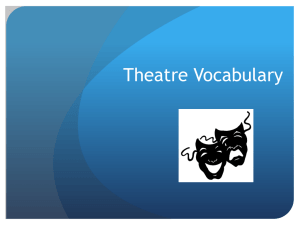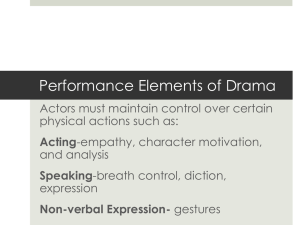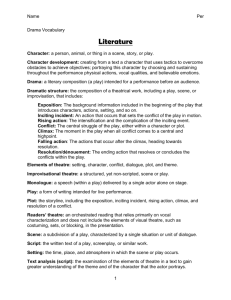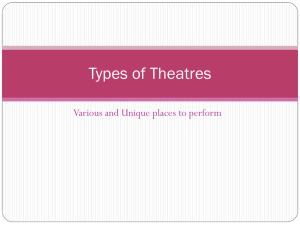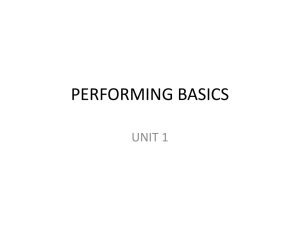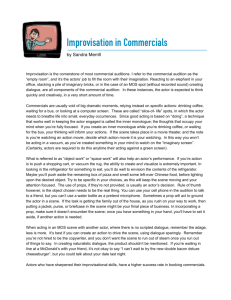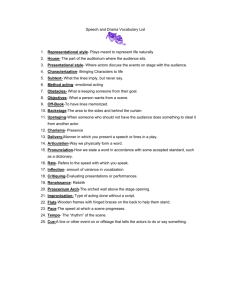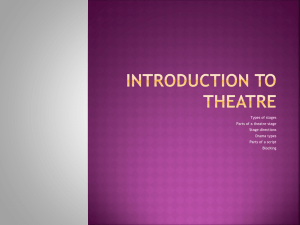Types of Stages and Important Terms
advertisement
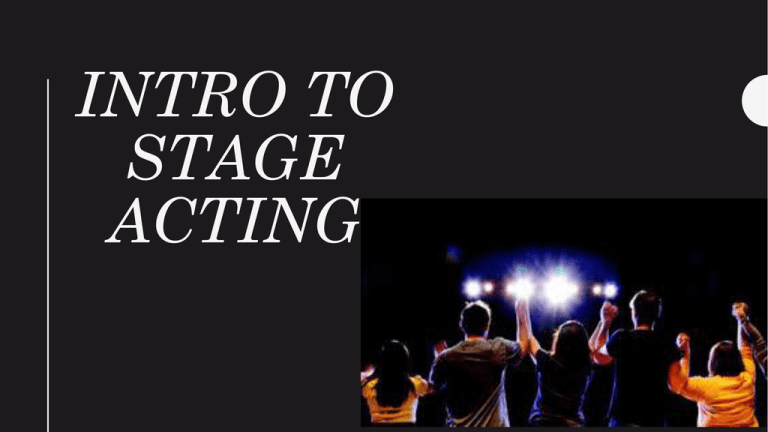
INTRO TO STAGE ACTING Types of Stages and Important Terms • Stage – the area where the players perform; usually a raised platform • Proscenium Stage – a 4-sided stage built like a box with one side cut away. It literally translates to “picture frame” because the cut away side enables the audience to view the action through what appears to be a picture frame. Types of Stages and Important Terms • Grand Drape – The draperies covering the proscenium opening, separating the audience from the stage. • Wings – Offstage space to the sides of the acting area. • Apron – The part of the stage extending past the proscenium arch extending towards the audience. Proscenium Stage • The most common stage in educational theatre. • The grand drape can be opened to reveal the picture, or the scene, to the audience. • Entrances onto the stage are made by the actors from offstage spaces to the right and left of the acting area called the wings. • Scenes are sometimes played on the apron in front of the grand drape, while the grand drape is closed. This is often while the set is being changed behind the curtain. • A proscenium arch creates a "window" around the scenery and performers. • The advantages are that it gives everyone in the audience a good view because the performers need only focus on one direction rather than continually moving around the stage to give a good view from all sides. • A proscenium theatre layout also simplifies the hiding and obscuring of objects from the audience's view. Anything that is not meant to be seen is simply placed outside the "window" created by the proscenium arch. • The side of the stage that faces the audience is referred to as the "fourth wall". The phrase "breaking the fourth wall" refers to when a performer addresses the audience directly as part of the production. Types of Stages and Important Terms • Arena Stage – A stage constructed so that the audience can sit on all sides, also known as “theatre-in-the-round” or “central staging” The Arena Stage • The stage is always in the center with the audience arranged on all sides. • Commonly used shapes can be rectangular, circular, diamond, or triangular. • It has no traditional backstage, so actors enter and exit through the audience, from different directions, or from below the stage. • The stage is usually on an even level with or lowered below the audience in a "pit" or "arena" formation. • This is good for anything that requires audience participation. It is favored by classical theatre. • Theatre-in-the-round was common in ancient theatre, particularly that of Greece and Rome . • The arena stage removes the fourth wall and brings the actor into the same space as the audience. This is often a problem for actors who are taught that they must never turn their backs to the audience; something that is unavoidable in this format. However, it allows for strong and direct engagement with the audience. Types of Stages and Important Terms • Thrust Stage – A stage that extends into the seating area. The audience sits on three sides of the stage. Thrust Stage • Also known as a platform stage or open stage • Extends into the audience on three sides and is connected to the backstage area by its upstage end. • A thrust has the benefit of greater intimacy between performers and the audience than a proscenium, while retaining the utility of a backstage area. • Entrances onto a thrust are made from backstage, although some theatres provide for performers to enter through the audience. • Because the audience can view the performance from a variety of perspectives, it is usual for the blocking, props and scenery to receive thorough consideration to ensure that no perspective is blocked from view. A high backed chair, for instance, when placed stage right, could create a blind spot in the stage left action. • Many of the works of Shakespeare were first performed on the thrust stage of the Globe Theatre. Types of Stages and Important Terms • Black Box Theatre – A black box theater (or experimental theater) consists of a simple, somewhat bare performance space, usually a large square room with black walls and a flat floor. Black Box Theatre • Such spaces are easily built and maintained, and are usually used for plays or other performances with very basic technical needs, such as limited set construction. • Common floor plans include thrust stage, modified thrust stage, and arena. • A Black box theater can be adapted from other spaces, such as hotel conference rooms. • The interiors of most black box theatres are, true to their name, painted black. • The absence of color not only gives the audience a sense of "anyplace" (and thus allows flexibility from play to play or from scene to scene), it also allows individual lighting cues to be much stronger. • Colleges and many theatre schools often use the black box theater because the space is versatile and easy to change. • Many theater training programs will have both a large proscenium theater, as well as a black box theater. Not only does this allow two productions to be done at the same time, but they can also have a large extravagant production in the main stage while having a small experimental show in the black box. Types of Stages and Important Terms • Found Space Theatre – Theatre made by converting a space that was not originally intended to be a stage into a stage. Found Space Theatre • A stage can be improvised where ever a suitable space can be found. • Examples may include staging a performance in a non traditional space such as a basement of a building, a side of a hill or, in the case of a busking troupe, the street. • Frequently used in very modern productions. Stage Terminology • The theatre has a language of its own. Knowledge of its basic terms is as important to actors as knowledge of the alphabet is to a child learning to read. • House – The section of the theatre where the audience sits. Also called “out front” • Blocking – The movements of an actor during a production. • Onstage - Anything within the stage and is visible to the audience • Offstage - Anything that is not visible to the audience • Backstage – The rooms behind the stage, not visible to the audience where the actors get ready for the performance and spend time when not on stage. • Acting Areas – 9-15 divisions of the stage floor, used by directors when moving actors and set pieces. Acting Areas ALWAYS from the actor’s perspective From the audience perspective is known as audience left and audience right. Upstage and Downstage terms originated because stages used to be raked. The directors challenge is to use these stage directions to block the show creating depth and to position the action so that everywhere in the audience has a good view of it. Acting Technique Vocabulary • Stage Picture – An appealing and meaningful arrangement of performers at any given point on the stage. The picture that the audience sees. • Planes – Imaginary divisions giving depth to the proscenium stage. • Body Positions – The five different angles that an actor’s positions onstage can be described in relation to the audience. • Open Up – To position or turn the body more towards the audience • Turn In – Turning the body more towards center stage • Turn Out – Turning the body more towards the side of the stage. • Cheat Out – All actors in a conversation turning more towards the audience than they would in a normal conversation. Acting Technique Vocabulary • Upstage –The acting technique of moving back on the stage, away from the audience, so that another actor must turn her back toward them. When you upstage someone, the audience's focus shifts from that person to you. • Share – The actors onstage assume positions of equal strength by opening up to the audience equally, thus sharing the scene equally. • Give – (give scene) When an actor moves to a different part of the stage to allow another actor more emphasis or attention. • Take – In the above definition, the actor that is getting more emphasis when another actor gives, “takes” the scene. Getting to Know Your Character • Character Analysis – As soon as you are cast in a performance or scene, the first thing you need to do is analyze your character. This is SUPER important. It will help you make the right decisions when scoring your lines and using your instincts. – Important things to include in a character analysis- Character traits? What is your character’s relationship to every other character in the show? How does your character change throughout the production? What are your character’s likes and dislikes? What happened to your character before the scene/show starts? Why is your character doing what s/he is doing? What does s/he want? How is s/he going to get that? What are some very important things to him or her? • Sometimes these questions are answered in the script and sometimes not. If the questions are not answered for you, you have to look at the information given and make up answers that follow along with the script. • Sometimes the script will cause more questions that need to be answered. Be sure to read it several times before and while you analyze your character. • Example – Let’s think of two different ways to analyze Goldilocks to show you the importance of this. Scoring Your Scene • Scoring your scene means that you should be writing everything that your character is thinking and feeling.. • There should be writing all over your paper like in the example. • Throughout your script, you should be writing each time your character changes emotions. • Write an F: and then what your character is feeling. • Then connect that to a time when you felt that way. Write a C: and then a brief one or two word description of that event to remind yourself of that emotion. • At each point where your character is trying to do something, you need to know what your character is doing and how they are doing it. These are called your tactics. • This helps you visualize your emotion changes when studying your lines. Blocking Terms • Blocking – Planning the movement for a scene or play. • Cross – Moving from one point on stage to the next. • Composition – The way actors are grouped onstage. • Dress Stage – When directors and actors look at the composition and adjust their position to balance or improve the stage picture. • In rehearsal, ALWAYS write down blocking in pencil. It is the actor’s responsibility to remember blocking, but it can change, so make sure it is easily erasable. Things to Consider When Rehearsing and Performing • Visual cues – Every day we receive over 90% of our communication without the use of words, through nonverbal messages/visual cues – facial expressions, gestures and body language are all important to convey the characters thoughts, feelings, and emotions. • Motivation – The purpose or reason behind a move or acting choice. Must be natural and true to the character. • Levels – Different levels allow for a more interesting stage picture. Some examples of different levels are: – Standing and Kneeling – Sitting on Floor and Standing on Box – Sitting and Standing – Sitting on a Ladder and Standing on the Floor. – Sitting on a Chair and Sitting on the Floor • ACTIVITY!! – Sit, Stand, Lean Important Items for Your Final Performance • Setting – The place and time that the show takes place. • Set – The background of the performance that shows where and when each scene takes place. • Costume – Any article of clothing that the actor wears. It needs to go along with the setting, correctly represent the character, allow the actor to do the movements that s/he needs to, and fit the director’s vision. • Props – Any object that is required during the scene (ex, Phone, Wallet, Cane, Papers, etc) • Projection – Speaking loud enough so that the audience can hear you. • STAY IN CHARACTER!!!!!! My Expectations of Your First Performance • STAY IN CHARACTER • Have some sort of blocking done. • Have any props that are NECESSARY to your script. • Have any set pieces that are NECESSARY to your script. • Know your script enough that you don’t have to stare at it the entire time. • Interact with other actors. • Have a good understanding of your character. What s/he is trying to do, what is stopping him or her from getting it, and how s/he is going to get what s/he wants. • Have your scene scored and work on showing emotions. My Expectations for Your Second Performance • STAY IN CHARACTER • Be completely memorized • Have blocking finalized. • Have any props that you are using. • Have any set pieces that you are using. • Have any costumes that you wish to use. (Not a requirement, but if one person in the scene is costumed, then all need to be costumed) • Fully interact with other actors in a realistic way that makes sense to your character. • Make sure you are acting and reacting to all the is going on, not just your own lines. • Fully understand your character. What s/he is trying to do, what is stopping him or her from getting it, and how s/he is going to get what s/he wants. • Have your scene scored and show emotions. • Take any notes from your first performance and improve upon your previous performance. Make this one better than the last!
